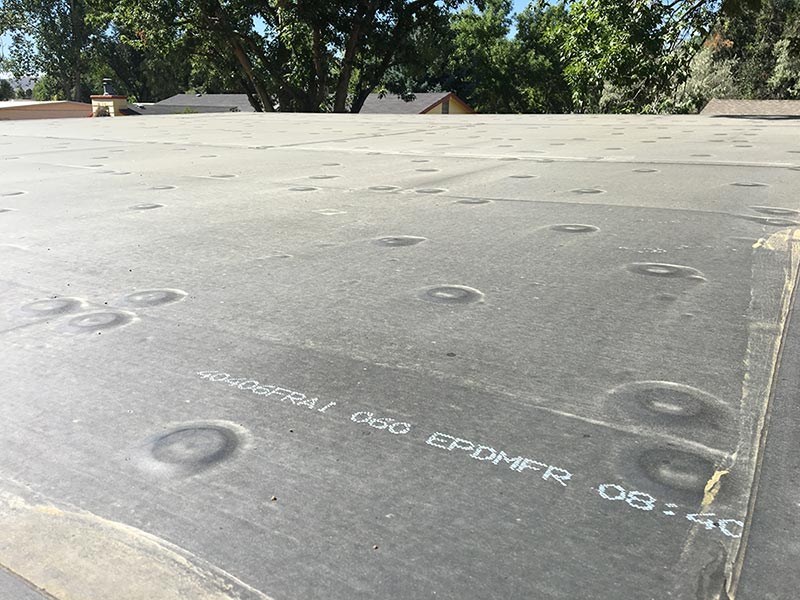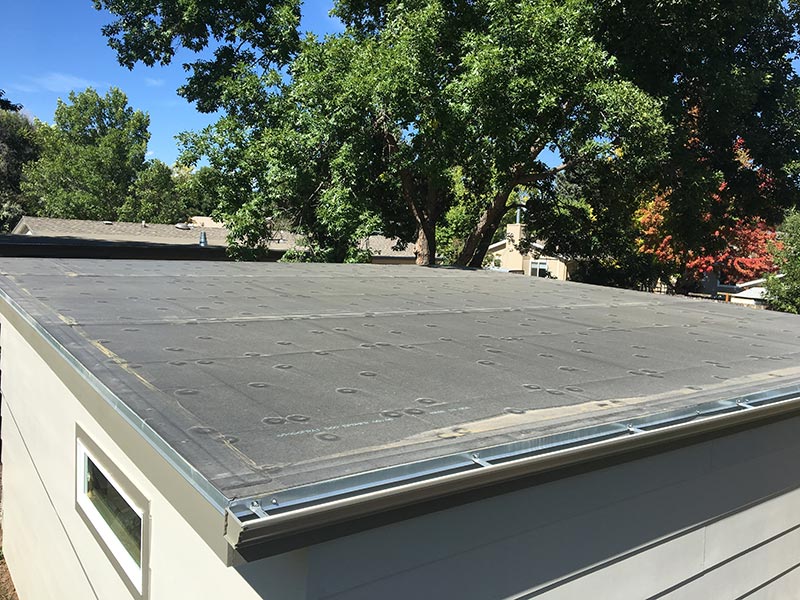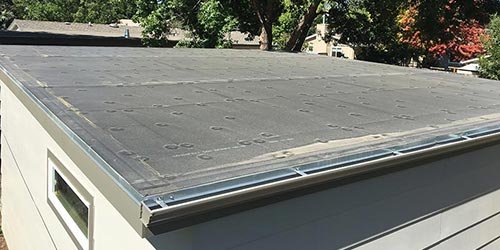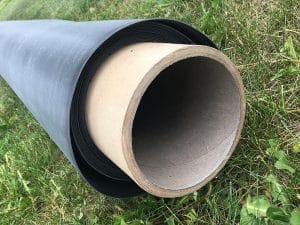What is EPDM Roofing?
As with any roofing system, there are advantages and disadvantages. One might be better for a specific situation, while another might be cheaper to install. Below, we discuss what an EPDM roof is, and the pros and cons of one.
Let us know when you’re ready for your new EPDM roof.


The Rubber Roof
EPDM, commonly known as a ‘rubber roof’, stands for ethylene propylene diene monomer. It is an extremely durable synthetic rubber roofing membrane. Although it is most commonly used on low-slope, also known as flat roof, commercial buildings, it is also used for residential purposes such as on car ports and patio roofs.
EPDM is available in either black or ‘white’. The ‘white’ version of EPDM is actually an additional layer on top of the existing EPDM layers.
EPDM comes in widths ranging from 7.5′ to 50′, and is available in 45 mil (1.1mm), 60 mil (1.5mm), 75 mil (1.9mm) and 90 mil (2.3mm) thicknesses.
- FlexWhite (Top layer. optional), the white-on-black layer that reflects sunlight
- FRM EPDM (Top layer), the layer reinforced with polyester fabric for greater strength
- AFR EPDM, the fire retardant layer
- EPDM (bottom layer), the elastromeric layer

Contact us today for a free EPDM roof estimate.
What are the advantages of an EPDM roof?
Least expensive to install
By comparison to TPO and PVC, EPDM is the least expensive commercial roofing system to install. For example, a 2500sf EPDM roof would cost around $5.5/sf to install. That same roof with a TPO roofing system will cost you roughly $7/sf. PVC, $8.5/sf. (figures do not include material)
Least expensive to repair
Because EPDM rolls are wide and long, there are fewer seems to fail, compared to asphalt shingles or metal sheets. As a result, the potential leaks that might occur are rare, especially with a thicker membrane, such as 75 or 90 mil, or if the roof is ballasted.
Longest lasting
EPDM is the longest lasting of the 3 commercial roofing systems we offer. Most owners enjoy 30 years or more out of their so-called rubber roof. A properly, professional installed, well-designed and constructed EPDM roof will outperform almost any other roofing system.
Light-weight
At only half a pound per square foot for 60 mil, fully-adhered, membrane-only EPDM, it’s significantly lighter than your average asphalt shingle, which weighs roughly 2.3lbs per square foot.
Fast and easy to install
Because EPDM is manufactured in large sheets or rolls, it is quick and easy to install. A common EPDM roll size is 10′ wide and 100′ long. Compared to asphalt shingles, which are roughly 3′ wide x 1′ tall. Instead of placing each asphalt shingle one at a time, you simply roll-out EPDM – you can cover more area faster.
Hail, ozone resistant
Since EPDM is essentially rubber, hail stones simply bounce off. If you live or work in an area that gets a lot of large hail stones, you should opt for the thicker 75 or 90 mil membrane, and possibly a ballasted layer. EPDM has an ozone-resistant rating of ‘A’ up to 100º F.
Energy reduction
EPDM is a good option regardless of whether you live in a hot or cold region. In the cold North, you might prefer black EPDM due to it’s ability to absorb heat and help warm the inside of your building, helping to keep your heating bill down. In the warmer South, the white EPDM membrane reflects the sun’s heat and helps reduce heating bill.
We are proud to install commercial roofing systems from the industry’s best brands:
We only use the best products. Our supplier’s meet California Title 24, are CRRC Rated, and Energy Star listed.
Wide operating temperature range
It has a minimum operating temperature of -40º F and a maximum operating temperature of 300º F.
Fire-rated
With the addition of the AFR layer in the EPDM roofing product, the overall EPDM roofing system is fire-resistant.
High-wind resistant
Because EPDM comes in large sheets or rolls, and the seems are fully adhered, there are no edges for the wind to get under and pick up. Asphalt shingles, tiles and metal sheets, on the other hand, are manufactured in much smaller pieces and are more prone to being blown off.
Almost 100% recyclable (check your area)
Ultraviolet radiation resistance
Does not pollute rainwater
What are the disadvantages of an EPDM roof?
Not DIY
Although you can purchase EPDM at department stores such as Home Depot, and install it yourself, you really shouldn’t. When installed incorrectly, such as on top of asphalt shingles, an EPDM roof will fail. Only a qualified EPDM installer, such as ourselves, should install an EPDM roof.
Can puncture easily
Depending upon the object and the membrane thickness, EPDM can puncture. No roofing system is 100% resistant to everything. Although a ballasted EPDM, fully adhered roof comes really close. If your building is in an area that’s in danger of falling debris, such as tree branches, or heavy foot traffic, opt for a thicker membrane, such as 75 mil. A ballasted roof also helps protect the EPDM membranes from punctures from tree branches.
Appearance
Without ballast, such as rocks, EPDM is just a large sheet of black or white rubber. Nothing to brag about.
Poor petroleum resistance
EPDM has a poor resistance to petroleum-based products, as it begins to breakdown when it comes in contact.
What is a ballasted roof? What does ‘ballast’ mean?
A ballasted roof is a roof with something, such as rocks or concrete pavers, to hold the roofing membrane, such as EPDM, down. The ballast also helps protect the roofing membrane from damage, such as from hail, tree branches and ultraviolet light.


I live in Southeastern Illinois and have a flat roof that is 16ft by 35 ft. A roofing specialist gave me an estimate of $4950.00 to install. Is that an average installation cost? Thanks
Seems about average in our market, will likely depend on if it’s fully adhered and if any recovery board/insulation is used.
What adhesive and cleaner are safe to use with EPDM? I read about one adhesive that is used to apply EPDM that states, “Not to be used for rubber to rubber.” So how do you repair tears?
The adhesive for rubber to rubber repairs is called splice adhesive, it’s black in color. Yellow (bonding) adhesive is used for gluing the rubber to anything else.
My roofer’s just installed a thin layer in a valley known for leaks. Just yesterday. I noticed several places with hand size bubbles. What causes this? Should it be redone?
EPDM is strong enough to be installed in a valley and is probably the best solution if it’s a low slope valley near a cricket – there are no laps in the material. I would have the roofer evaluate what could be happening on the interior by accessing the attic.